This year is the 50th anniversary of the first National Women’s Liberation Conference, which was held at Oxford in 1970 and attracted over 600 feminist activists from across the country. This year’s conference, organised by Woman’s Place UK and the UCL Women’s Liberation Special Interest Group, offered 30 workshops, 5 panel discussions and 2 plenaries.
The capacity of Logan Hall, the main lecture hall ,is 933 and tickets completely sold out. Add to that number the event volunteers, organisers and those involved in the marketplace and we can conclude that close to a thousand people- almost entirely women- attended the conference.
It was an early start as we were aiming to arrive at UCL before 9.30am, less so for me than for many. I just had to take a short two-tube-hop: I knew women who had driven up from Brighton and down from Manchester; women from all over the country who had come to London early and stayed the night with friends – some had even flown in from other parts of the UK.

It was not a long walk from Euston station to the venue. I bumped into Estelle on the way and we walked together. As we approached we could hear chanting. Ahead of us were a small group of 20 or 30 excited young people holding up placards bearing inspirational slogans.
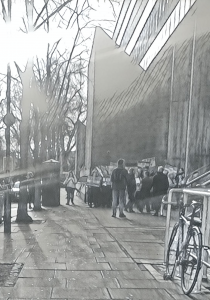
‘Get on the Trans Rights Train’
‘I don’t know… show kindness’
‘sister not cis-ter’
‘break the binary’
‘transphobes are womanphobes’
and, of course,
‘transwomen are women’.
The best of the bunch, which became the subject of a lot of Twitter speculation as to what it could possibly MEAN, was the mind-mashing ‘‘there’s no CIS in TEAM‘.
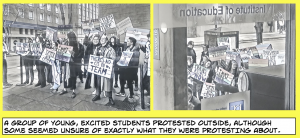
Later we discovered that the banners had been made at a special workshop run by ‘the Women’s Network Student Union UCL’ who urged people to make ‘banners and quirky masks’ for the protest. The ready-striped shiny card and chunky felt tip pens- and yes, that IS glitter glue you’ve spotted there- led to much hilarity on social media.
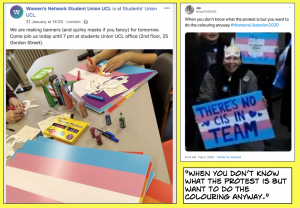
Make of it what you will. We passed them by and moved into the venue to register and collect our wristbands and programs.

Inside the conference
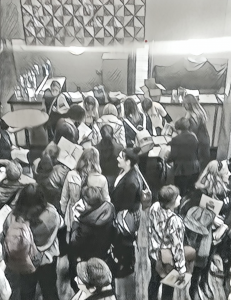
Attendees collecting programmes and itineraries.
Those who didn’t wish to be photographed or filmed were given a yellow ribbon to wear on their lapel. Estelle took a yellow ribbon but looked unhappy about doing so.
“It’s fine,” the volunteer assured Estelle as she pinned it onto her coat. “Really, it’s ok. There are lots of good reasons for not wanting to be recorded.”
How archaic it should seem, the idea that women would be frightened to be identified at a meeting held to discuss women’s rights! And yet those who took the ribbons had every right to feel afraid. They know the stories of those women who have been punished for speaking up, losing jobs, friends and more.
(I write about ‘the invisible women’ of feminism here).
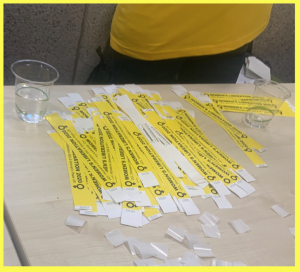
After greeting a few familiar faces we headed down the stairs to the foyer, where a display of painted and patchwork banners hung from the balconies. I wish I had photographed more of them but I was somewhat distracted by my attempts to find the promised coffee.
The program quite definitely said there would be coffee but despite my best efforts I failed to locate any, although there were jugs of water available. Luckily I’d considered that possibility and had a flask of super-strong espresso in my backpack. It is essential to be prepared at all times, I congratulated myself. I later discovered that there was not only coffee but pastries were also available in the main hall. How did I miss that?

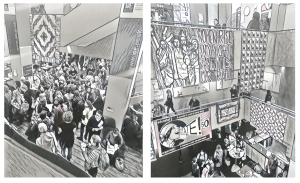
By the time we’d visited the loos, offloaded our coats and greeted more old friends, it was time to move into the lecture hall for the first plenary.

The first Plenary

As we entered the hall, thanks were being given to Woman’s Place and the UCL.
Sophie Scott jokingly described herself as ‘an extremely boring brain scientist’, as she pointed out the fire exits and the yellow T-shirt clad volunteers. We were told to keep our wristbands on in case we wanted to go outside and come back, and asked to “respect the space, respect our speakers and… respect each other.”
We were encouraged to Tweet with the hashtag #WomensLib2020.
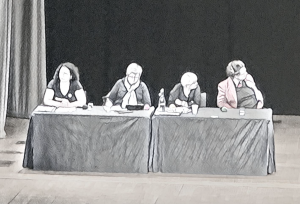
Left to right: Maya Forstater, Joanna Cherry, Pragna Patel, Sophie Scott
I have to say, I was a bit baffled and initially slightly miffed when the first person to speak turned out to be a bloke. For a moment I thought Scott was introducing Brad Pitt (it was actually Professor Brad Blitz). This Brad was from the UCL Institute of Education, hosts of our conference, in whose building our meeting was taking place. He spoke for a few minutes and wished us a successful conference.

Pragna Patel
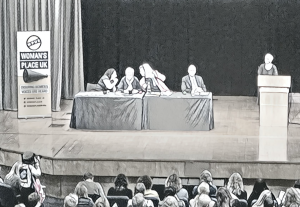
Pragna Patel takes her place at the rostrum
Patel was introduced as a founding member of Southhall Black Sisters (SBS), a campaigner ‘absolutely at the heart of our bid for women’s rights’.
“What a welcome, thank you. Hello sisters!” she greeted us. “Let me start by saying something that’s completely not scripted: let’s own free speech.“
When the applause had died down she continued.
“I want to say why I’m hopeful. All over the world, women are leading an unmistakably secular resistance against tyranny, misogyny and oppression.”
Patel continued to tell us that despite ‘growing social, political, economic and climate crisis… there is a new kind of feminism stirring in the air’ and that this was a feminism founded on politics not identity. ‘Waves of ordinary, marginalised and poor women are rising up’ she told us, speaking of gatherings of women in Chile defiantly chanting anti-rape songs and of Indian Muslim women protesting against the ‘controversial and discriminatory’ Citizenship Amendment Act and National Registration Act which ‘parallel(ed) the introduction of the Nuremberg Laws in Nazi Germany”. These Acts, she said, were ‘a direct attack on Muslims and the poor’, and she praised the rising protests against them.

Pragna Patel
“The defence of India’s secular constitution is not about the defence of some abstract concept but a living, breathing ideal and the protests around it are increasingly seen to be signifying India’s second freedom struggle.”
By the 70s and 80s, second wave feminism was in action. Campaigns for equal pay, better working conditions, the right to contraception and abortion and for shelters for victims of domestic violence were all taking place.
Pragna acknowledged that the Women’s Liberation Movement of the time ‘was not without its internal divisions and tensions‘. Black feminists were challenging the movement to acknowledge the importance of racism as a key issue, and its failure to include black and minority women’s voices in the making of feminist history.
The secular term ‘black’ she said, was vital in the challenging of racism in the UK and uniting Asian and Afro-Carribean women, “and that is why today SBS refuses to relinquish the term black. For us, it has come to symbolise unity across difference that in today’s fractured and polarised political climate is more relevant than ever.”
Black feminists of the time had raised awareness of racist and sexist issues like virginity testing, forced sterilisation and also challenged racist police stop and search procedures. She reminded us of the importance of the work of groups like the Brixton Black Women’s Group and the Organisation of Women of African and Asian Descent.
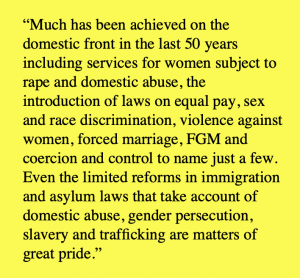 Patel spoke of how groups like SBS had criticised government policy approach to multiculturalism for ‘creat(ing) the space for unelected community representatives, usually from religious and business classes, to act as mediators between the community and the state.’ She reminded us of the successes that have been achieved on an international level.
Patel spoke of how groups like SBS had criticised government policy approach to multiculturalism for ‘creat(ing) the space for unelected community representatives, usually from religious and business classes, to act as mediators between the community and the state.’ She reminded us of the successes that have been achieved on an international level.
‘We haven’t yet found a way to get rid of the cul-de-sac of identity politics,’ she declared to much applause, going on to criticise the ‘academic and activist feminists who work with, for example, religious conservative and fundamentalist frameworks to counter imperialism and racism’ observing that religious power ‘uses the very structures of democracy in political, legal, cultural and social spheres to subjugate women’.
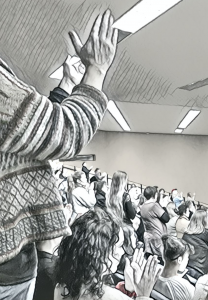
Loud applause greeted the end of Patel’s speech.
All over the world, asserted Pragna, women were calling power to account: “naming and shaming… occupying public spaces, organising rallies and sit-ins and draping themselves with the symbols of peace, unity and justice.”
As we move forwards and pay tribute to the feminists that have come before us, she concluded, “there is so much to celebrate and yet so much also to critically reflect upon; so much to get angry about and yet much to feel hopeful about.”
You can read a short synopsis of the work of Pragna Patel, and the script of her speech in its entirety here.
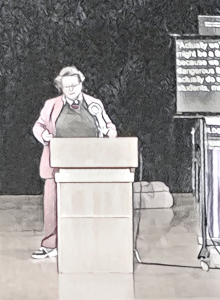
Sophie Scott
“That was absolutely wonderful,” avowed Sophie, before introducing the next speaker, Joanna Cherry, who she described as “extraordinary in her principled and thoughtful insistence on having conversations around proposed changes to the Gender Recognition Act.”
![]()
Joanna Cherry, QC MP
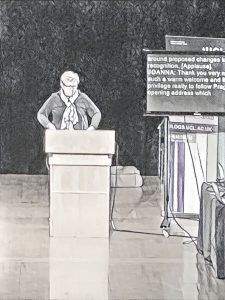
Joanna Cherry
When the applause died down, Cherry thanked us for the warm welcome, praising Patel’s opening address as ‘wide ranging and thought provoking‘. To much applause she paid tribute to the bravery of the people of UCL in hosting the conference, observing- to even louder applause- that it’s ‘ludicrous that it requires bravery to host a conference’.
She talked about the first Women’s Conference in 1970 and of a friend whose big sister remembered it. Joanna was a toddler at the time, busy rolling her mum’s tins of baked beans down the hill outside their house, observing that there was no gender stereotyping in her childhood. University was her first experience of how ‘belittling and marginalising some men could be to women’s voices’.
Joanna came out as a lesbian at university, when there was a vibrant and united gay movement against Section 28. She spoke of the AIDS crisis, with a balance of seriousness and humour, and her sadness of how the LGB movement has ‘become fragmented over our resistance to talking about the true meaning of equal rights‘.
Cherry once feared that as a lesbian she would never be able to go into politics. Time spent as a specialist sex-crimes prosecutor has made her very aware of the importance of single sex spaces.
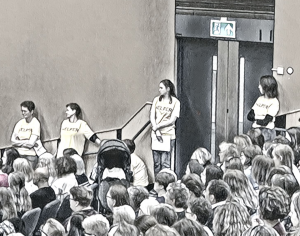
Event volunteers listen to Cherry’s speech.
She said she had started out as a radical feminist, then ‘I forgot about it for years, having being lulled into a false sense of security in the legal world’. Entering politics made her realise again what a problem misogyny was. Speaking of a study about abuse of female politicians online, she told how she had found herself to be the second-most abused female MP (after Dianne Abbot).
Cherry observed that Twitter ignores sex-based abuse and silences women’s free speech ‘in relation to certain debates’, specifically those around male violence and stating that women don’t have penises. When she spoke up she was accused of bullying but was able to have the charges looked into and to be exonerated. She mentioned Pink News, who had accused her of homophobia, and the audience groaned. Joanna observed sadly that ‘The Pink Paper’ had been ‘the forum of the gay community’ in the 80s.
‘I really believe that women’s rights are human rights and I strongly believe in equal rights for everyone and of course that includes trans people… there has never before been any part of the movement for equality (that suggested) one group’s rights should trump another.”
This was met with much applause and whistling.
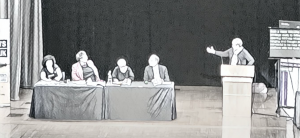
Cherry concludes her speech
Cherry spoke of the importance of the right to freedom of speech and freedom of assembly. She concluded that, despite her own political position on the left, she had observed that “people on the right seem much more vocal in the defence of free speech.. and that really needs to change.”
The applause was lengthy, and after it subsided Sophie Scott thanked Cherry for “a rousing defence of free speech, which brings us to our next speaker.”

Maya Forstater
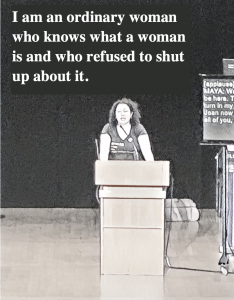
Maya Forstater
A new burst of applause broke out as Maya stood up and approached the podium.
I have heard her speak before, but that morning she was sublimely articulate in talking about ‘this unexpected turn in my life… here with Pragna and Joanna and Sophie in front of all of you’.
“I just wanted to talk about the difference between the idea of “gender identity” and the reality of sex, and about what the push to conflate them means for women’s rights. I wanted to talk about it, and wrote about it and tweet about it- and I lost my job.”
Maya had worked for the Centre for Global Development who claim these as their values:
“We are willing to challenge powerful institutions and the status quo to promote better, evidence-based practice (laughter from audience). We are committed to transparency, diversity, and professional and personal integrity… We value mutual respect, a collegial work place and a healthy sense of humor.”
Despite these values, which Maya insists are also her own, she lost her job, which she ‘really loved’. After a year of following conversations on Munsnet and on Twitter, of reading through nonsensical official documents, Mays told us she reached a point where “the balance between fear and caution on one hand and rage on the other, was tipped to a point where I couldn’t not speak up.’
A few months into Tweeting about the issue, her Human Resources department wrote to her, saying her tweet that ‘a man’s internal feeling that he is a woman has no basis in material reality’ was ‘problematic’ and potentially ‘offensive and exclusionary’.
After losing her job, Maya and her lawyers went to an employment tribunal with a case of ‘belief discrimination, and indirect sex discrimination‘. Forstater took four beliefs to the tribunal.
For something to qualify as a philosophical belief it doesn’t mean other people have to agree with that belief, nor do they have to pretend to believe it; nor do they even have to say they respect it – they just have to not treat someone badly because of it.
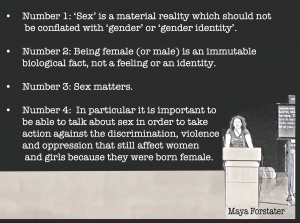
“All of these things relate to the way that society treats the people with the kinds of bodies that can ovulate, gestate and lactate, and the way it treats the people with the kinds of bodies that can impregnate. And to talk about these things it is really helpful to have WORDS.”
Maya went on to say that our mother’s generation had the words to talk about these things but our daughters are not allowed to state that women are female, or that woman is not an identity. She does not believe that everyone has an innate gender identity, and feels she should not be compelled to pretend she does.
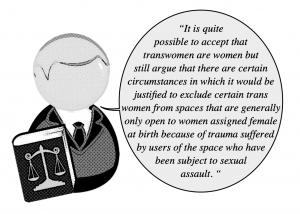 The judge in Forstater’s case disagreed, calling her beliefs “absolutist” and “not worthy of respect in a democratic society”. Ergo Maya should have no protection against discrimination for expressing them.
The judge in Forstater’s case disagreed, calling her beliefs “absolutist” and “not worthy of respect in a democratic society”. Ergo Maya should have no protection against discrimination for expressing them.
She has filed an appeal, of which she says, “fundamentally it is about whether it is acceptable to talk about women’s rights.”
Forstater has stood up to this ‘because I can’. She says her children are not very young and she has the support of family, friends on and offline and a brilliant legal team. If she can’t talk about sex in ordinary language, she points out, how much harder will it be for the very old or young and for other vulnerable groups of women? “We all need words.”
People from all political persuasions and parties, the religious and the atheist, stand united on this, “because a free society depends on protecting and defending the beliefs we do not share”.
Forstater questioned the integrity of organisations such as the Equalities and Human Rights Commission, Amnesty and The Fawcett Society, accusing them of “retreat(ing) into silence or mind numbing simplistic slogans… there are too many to count, and my disappointment with them is bottomless.”
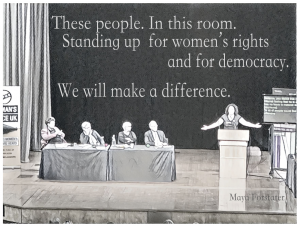 Noting that the public response to the government’s consultation on the GRA resulted in it realising that self-ID is neither simple nor a good thing, Maya urged everyone to fill in a form on the Scottish government’s consultation on self-ID, adding that the Scottish consultation is ‘live and urgent, and what happens in Scotland will affect the rest of the UK‘.
Noting that the public response to the government’s consultation on the GRA resulted in it realising that self-ID is neither simple nor a good thing, Maya urged everyone to fill in a form on the Scottish government’s consultation on self-ID, adding that the Scottish consultation is ‘live and urgent, and what happens in Scotland will affect the rest of the UK‘.
Maya finished to great applause and when it died down Sophie took the opportunity to introduce the panels and let us know where we should go to find them. There were five panels and we could only attend one as they ran concurrently. It was hard to hear Scott over the enthusiastic chatter that had started up, but eventually we all headed off to our designated panel.

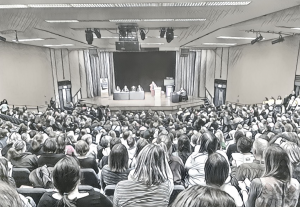
Sophie Scott addresses the conference after the first plenary.
I had absolutely no idea where I was going. Had I thought to look at the itinerary the organisers had so obligingly printed out for those of us who had booked our spaces in advance, it would have been made clear, but it was in the bottom of my bag under a flask of coffee, a bag of pombears, a hairbrush shaped like a unicorn and a cardigan.
I left the hall and wandered round in a circle before realising that my panel was taking place right back where I’d started.
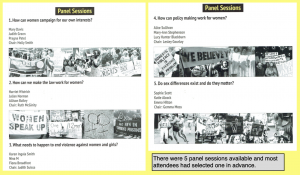
Arriving sheepishly back at Logan Hall I took my seat, closer to the stage this time as many of the conference attendees were off at other panels. I had chosen Panel 5.

Do sex differences exist and do they matter?

Gemma Moss introduces the panel
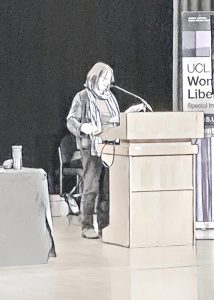
Gemma Moss
I missed the very start of the panel, so I can’t report on Gemma Moss’s introduction. As I took my seat she was finishing introducing the panel and describing herself jokingly as ‘the surface ring master’.
I just had time to take my seat and pour myself a small cup of coffee from my flask before Moss was asking Emma Hilton to “come up to the microphone and start us off.”

Emma Hilton
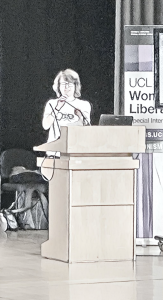
Emma Hilton takes to the podium
Emma Hilton introduced herself and started us off with the basics.
“Sex is the way humans make new copies of themselves. We have 2 individuals and each package half a share of their DNA into cells that we call gametes. These two halves are fused and they make a new whole copy. Unless you are a mushroom or the black slime stuff that lives on your windowsills you will reproduce using gamete sizes that are different… a large one which we call female and a small one which we call male. This is the most basic difference between the sexes… in humans it’s quite an extreme size difference, a human egg is 100,000 times larger than a sperm… anyone who says sex doesn’t exist is an idiot.
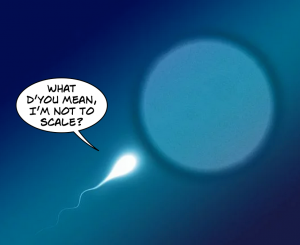 All embryos start out sexless. At 7 weeks gonads (testes or ovaries) form and these drive anatomical differences in the hormonal environment they create.”
All embryos start out sexless. At 7 weeks gonads (testes or ovaries) form and these drive anatomical differences in the hormonal environment they create.”
This results in boys being taller and stronger, even prepubescence. At puberty we undergo a ‘massive physiological change‘. Evolution drives male bodies to have increased height and muscle as part of the drive to search for a mate. Hilton’s field of interest is sport, which she describes as ‘a pure measure of the physical differences‘. Males are better at sports, she tells us, because of the result of the huge surge of testosterone triggered at male puberty. Men are on average 5 inches taller, longer legged, lower hipped, bigger lunged: they have 40% more muscle and 40% less body fat even when controlled for height.
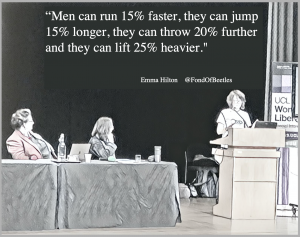
Emma Hilton gives us some science
“The actual composition of a male muscle is different to the composition of a female muscle… they can run 15% faster, they can jump 15% longer, they can throw 20% further and they can lift 25% heavier.”
The gap between male and female performance in sport did lessen but plateaued about 30 years ago and had not decreased since.
“The number of men that can fill the gap before the best female number into the thousands. It’s insurmountable and we need this protected category. It’s not anti-feminist to say that females are slower or weaker, it’s a basic statement and a material fact… it is anti-feminist to ignore the physical differences.”
Hilton took her seat to much applause and without ado, Moss introduced Sophie Scott.

Sophie Scott
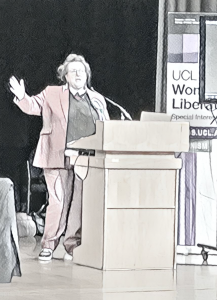
Sophie Scott addresses the audience
Sophie told us she was going to talk about sex differences, brains and behaviour. Some mammals, she said, had much greater differences in size between male and female and some scientists argue that this difference is related to the amount of involvement males have in care of the young.
One difference is that men’s brains are bigger, even if you control for body size. The grey matter is where the brain cells are; the computational part of the brain and the white matter connects the brain cells together. Although women’s brains are smaller, they have proportionately more grey matter than men. There are certain brain areas that are different in size between men and women, but you have to study thousands of people to pick up on these tiny differences and even then we don’t know if these differences come from our experiences ‘or are the way we come out of the box’.
The problem with saying oestrogen and testosterone (sex hormones) play a role is that “in the brains of men and women, testosterone, which is present in both, just more in men, gets aromatised into an oestrogen. This means an extraordinary thing: in the brain of a 65 year old man there is more oestrogen than in the brain of a 65 year old woman. There’s something very complicated happening there!”
Another big clue is that the brains of males and females are equally affected by damage. Although strokes and Altzheimers affect higher numbers of women than men, that is likely to be because, for all sorts of reasons, women are less physically fit to start with.
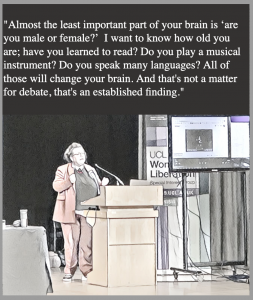 IQ almost completely overlaps between men and women. At the very, very low end you find slightly more men, possibly because genetically there are more things that can cause learning disabilities. At the very, very high end, there are a handful of men. These are “tiny, tiny differences” at the edge of distribution.
IQ almost completely overlaps between men and women. At the very, very low end you find slightly more men, possibly because genetically there are more things that can cause learning disabilities. At the very, very high end, there are a handful of men. These are “tiny, tiny differences” at the edge of distribution.
It is not a sexually dimorphic distribution.
“Almost the least important part of your brain is are you male or female. I want to know how old you are, have you learned to read, do you play a musical instrument, do you speak many languages? All of those will change your brain. And that’s not a matter for debate, that’s an established finding.”
We tend to believe, for example, that women have better language skills and men perform better in spatial cognition tests. Some tests may throw up very slightly different patterns but generally these distributions overlap and we can’t know if they have occurred because of differing life experiences. For example, children growing up in Tanzania and children growing up in Lancashire may have different spatial skills because they need to learn to negotiate different environments.
Likewise, boys and girls have different experiences growing up. Scott pointed out that people on average spend 20% more on raising boys and that most of this goes on paying for activities.
“My parents bought my brother a mandolin, a lute, a base guitar, an electric guitar, an acoustic guitar.. they never bought me any musical instruments at all.”

Science, kittens AND puppies! Some of us want it all.
Scott observed that at gatherings discussing the issue of women and science at the Royal Society there are always a couple of men who claim that there is no problem concerning the representation of women in science:
‘… for women’s brains simply do not work that way; it’s not in the nature of women to be interested in science, they are interested in kittens and puppies!’
When computer science first began, women were involved in equal numbers to men. In the 80s, the numbers of women greatly decreased and haven’t picked up again. Scott observes that this was the same time that computers began to enter the home and that they were marketed to boys and men.
“My brother had two ZX Spectrum machines bought by my parents – one of us grew up to be a research scientist who does her own coding – just saying!”
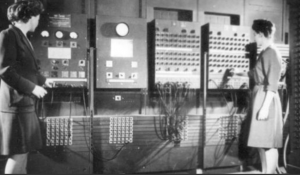
“Have you tried turning it off and on again?”
So to suggest that women aren’t interested in computing is not true. Initially, many were interested but they were put off by marketing strategies. Yet in parts of the world where computer skills are seen as secretarial, there are still large numbers of women working in computing. What are seen as difference between men and women are often the result of gendered expectations embedded in our culture.
Scott pointed out that there are 23 men in prison for every woman. Research has shown that 80% of these men have undiagnosed communication issues, a problem which is not to do with male brains but more likely to do with how we are raising boys.
There is research in psychology as to why some people are gay, but little into why most men and women are attracted to the opposite sex. Heterosexual orientation is not something we study. (Male) scientists didn’t even study sexual arousal in women until recently, now studies show that women show larger sexual responses to ‘a wider range of potentially sexual images’ than men.
Scott emphasised the importance of how we frame the question, whatever the question may be, and of looking carefully at the circumstances surrounding differences.
“We will continue picking away at things like IQ and not worrying at all about the male population we’ve got in prison, and if we don’t change that then I think we’re going to keep stuck in that same circle.”

Katie Alcock
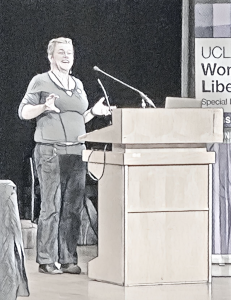
Katie Alcock
Alcock said she was going to be talking about the differences in the way children understand men and women. She had a series of slides to show us but unfortunately I couldn’t really make them out from where I as sitting, so I won’t be referencing them here.
Children work out what sex somebody is through two things, Alcock told us, their appearance and what they do. As young as 5 months old, children can start to discriminate sex appearances. Children of this age can also tell the difference between male and female voices. Babies looked after by men tend to prefer male voices. From the age of about two, children start to label people: boy, girl, man, woman. This has recently been interpreted as gender identity, ‘but it’s not a complex internal representation, it’s just the ability to label something. It’s the same as being able to work out which is a cat and which is a dog, which is a table and which is a chair. It’s a categorisation ability.”
She then showed us a short video which you can watch here.
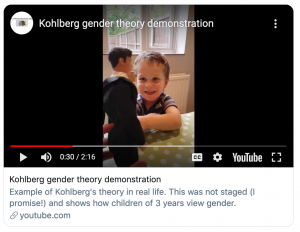
James is three and bases his idea of reality on appearance. When his dad asks how James knows he’s a boy, he replies “Cos I’ve got short hair.” Mummy, James assures us, is a girl because she’s got long hair.
When his dad shows him a ‘Ken’ doll wearing a dress, James identifies the doll as a girl.

Woof
If a cat puts on a dog mask, three year olds really think it’s now a dog, explains Alcock.
“They don’t understand that the reality of something and the appearance of something can contrast.”
 A child of four may still find this confusing. A child of ten, shown two dolls and asked what would happen if the interviewer took a sparkly handbag from a girl doll and gave it to a boy doll, replies,as if the interviewer is perhaps a bit daft, “the boy would have a purse.”
A child of four may still find this confusing. A child of ten, shown two dolls and asked what would happen if the interviewer took a sparkly handbag from a girl doll and gave it to a boy doll, replies,as if the interviewer is perhaps a bit daft, “the boy would have a purse.”
You can watch the video here.

Katie Alcock
This is called gender consistency.
Older children understand that boys grow up to be men and girls to be women: they understand that appearance does not always mimic reality. Children up to the age of about nine do not necessarily understand that changing appearance doesn’t mean changing reality. The example Alcock gave concerning the response of this older age group was, “they understand that a bunny puppet wearing a ghost costume is a bunny puppet wearing a ghost costume, not really a ghost.”
Aged about 3-5, children show a huge increase in stereotyping, often despite the best efforts of their parents. This tapers off somewhere between the ages of 7-9.
In the current climate, children in the peak phase of sex stereotyping are being told that if they like these things traditionally liked by the other sex, it means they may actually be the other sex.
To conclude her presentation, Alcock showed us another piece of film. In this video, a six year old trans-identified boy called Lily was interviewed concerning his feelings about what made him a girl.
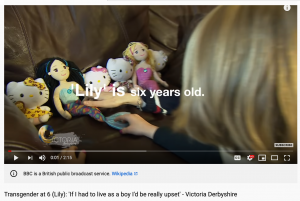
“I sort of am a girl. I like girl stuff. When I started wearing girl clothes to school I felt much better. I’ve got girl trousers, a girl cardigan, a girl top and girl shoes.”
The last video was met with an uneasy silence followed by applause.
You can watch that video here.
You can read a transcript of a similar talk of Katie’s from 2019 here.

Discussion

Gemma Moss
“Katie has raised some interesting questions about how we as a society create gender identities and how children grown into them.”
Moss asked the panel to respond first and then said she would open the discussion up to questions from the floor, asking one of the helpers to take a roving microphone around the audience.
During question time it was again asserted that you had to study thousands of brains to find even negligible difference between men and women, and that if you took 16 random different people there would be minor difference in all their brains.’ ‘We are desperate for male and female brains to be different!’ observed one panel member. Yet there are no studies suggesting they are, other than that male brains are bigger.
And trans-identified men’s brains are no smaller than the brain of any other man.
Another audience member asked how important parental input is at these key learning stages. A panel member said however much parents tried to raise non-sexist children, at a certain stage boys would always come home and say ‘pink is for girls!‘ (her own child branded any of his pink stuff as purple) because there are influences from the rest of society.
Another said she felt feminists didn’t want to discuss biology, but despite the small brain differences, biology leads to women being more willing to trade off public status against keeping children alive, this leads to inequalities. thus these small differences get embedded into big differences. A panel member spoke of new personality tests which show women as more extrovert, more agreeable, more neurotic- women come out as being more everything!
“We want to say that the brain is a blank slate… but it’s growing up in a world where different things present different challenges (to men and women)... you want to be able to speak up for where biology matters and where it’s important, and it is important that some of us bear children. It does matter! Every one is on earth because some women had the good grace to go through with this process.”
We ran out of time shortly afterwards and the hall filled up with conversation as everyone packed up their bags and headed off for lunch.

Lunch time
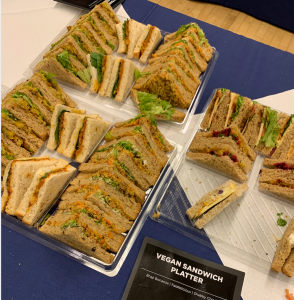
lunchtime sustenance!
Brilliant as the plenary and the panel had been, I was certainly ready for some lunch. My brain had been working overtime (I’d also been taking notes) so the break was welcome. Estelle and I went downstairs into a huge open hall and were greeted with tea, coffee (not as strong as I like it, but good) and plates of delicious veggie and vegan sandwiches.
A hot cup of coffee and a couple of sarnies later, I was ready to explore the marketplace.
 Transgender Trend had a stall, with copies of their schools packs (available here) and Heather Brunskell-Evans & Michele Moore’s books ‘Transgender Children and Young People’ and ‘Inventing Transgender Children and Young People‘ (available here).
Transgender Trend had a stall, with copies of their schools packs (available here) and Heather Brunskell-Evans & Michele Moore’s books ‘Transgender Children and Young People’ and ‘Inventing Transgender Children and Young People‘ (available here).
Rachel Rooney was also there, signing copies of her adorable children’s book ‘My Body is Me‘ (available here)
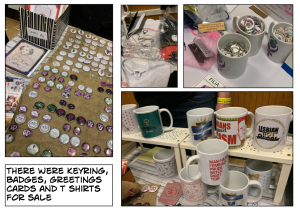
 Lunchtime seemed to pass very quickly. Perhaps it was because I’d been so busy stuffing vegan sarnies and talking to other women about the conference so far but I’d got less than halfway round the marketplace before it was time for me to head off and try to find my first workshop.
Lunchtime seemed to pass very quickly. Perhaps it was because I’d been so busy stuffing vegan sarnies and talking to other women about the conference so far but I’d got less than halfway round the marketplace before it was time for me to head off and try to find my first workshop.
I had time to buy a couple of mugs from the ever-wonderful WildWomynWorkshop stand and quaff a last cup of hot coffee (the dregs in my flask were now undrinkably tepid) and off I went, promising myself I’d return for another look after the workshops.
My program and itinerary were still forgotten in the depths of my bag, now buried deeper than ever under my lunchtime purchases. Had I consulted them I would have known the right floor and room number for my workshop. Instead, I walked up four flights of stairs, came down again, waited for a lift, gave up, walked up several more flights of stairs and along a corridor and eventually, perhaps more by luck than judgement, arrived at my first workshop.

Countering wrong body narratives
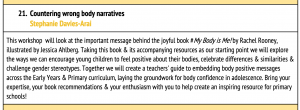
There were probably about 25 of us in the room, a smallish classroom with a whiteboard and projector.
This workshop was run by Stephanie Davies-Arai of Transgender Trend, who is also a sculptor.
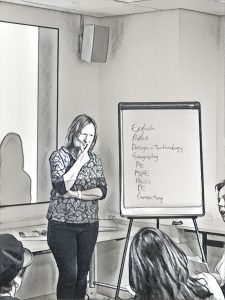
Stephanie Davies-Arai
After we settled back down into our seats, Davies-Arai spoke of how gender ideology is being embedded into every area of the primary curriculum, ostensibly through ‘LGBT’ inclusion.
Children are being introduced to the idea of being non-binary and the use of the pronoun ‘they’ to refer to a single person, and are being taught that ‘most boys have a penis and most girls have a vulva‘.
Our brief for the day was to help create an alternative to the Stonewall guidance: one which encourages body positivity.
 Davies-Arai said she has now counted 34 ‘trans’ books aimed at younger children. ‘This is the culture that our children land in today.’ She observed how extremely gendered the children’s toy and clothing markets had become in the last decade, and reminded us that’s what we have to counter: the idea that girls are ‘pretty, pink and passive and boys are active and aggressive and tough and macho’. This is quite probably why we are seeing such a rise in the idea of the transgender child, especially when parents buy into this narrative: parents are also being conditioned into buying gendered toys for their children.
Davies-Arai said she has now counted 34 ‘trans’ books aimed at younger children. ‘This is the culture that our children land in today.’ She observed how extremely gendered the children’s toy and clothing markets had become in the last decade, and reminded us that’s what we have to counter: the idea that girls are ‘pretty, pink and passive and boys are active and aggressive and tough and macho’. This is quite probably why we are seeing such a rise in the idea of the transgender child, especially when parents buy into this narrative: parents are also being conditioned into buying gendered toys for their children.
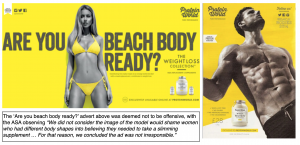
Davies-Arai referred to the ‘beach body ready’ adverts and how the ‘ideal body type’ is marketed to women. “She’s a decorative object waiting for your approval and appraisal” carrying the message that unless a girl looks like her, she really has no business being on the beach. While the man in the equivalent advert is in a more powerful pose- he both towers over and looks away from the viewer- the male body has also come to be objectified by the multi million pound cosmetic surgery industry. The number of men affected by eating disorders has risen by 27% in the last 20 years and the number of men undergoing plastic surgery has risen by 60% between 2008 and 2013.
“Lest we start feeling too sorry for those men, let’s remember that over 90% of cosmetic procedures are done on women.”
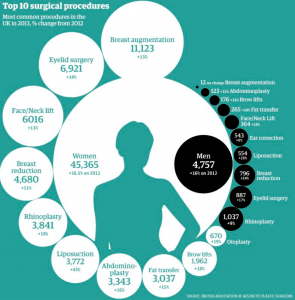
Girls feel pressured to comply with unrealistic and unattainable body standards: around 75% of those affected by eating disorders are female; around 10% of those have anorexia and the average age of onset is around 16-17 years old. So the school years are a very vulnerable time. (Statistics from a report by Plan International).
“What this has created for girls is a disassociation from the body. As women we are brought up to stand outside our bodies and self-objectify… we don’t inhabit those bodies, we are viewers of those bodies along with the culture. This inevitably creates mental health problems and a split between mind and body.”
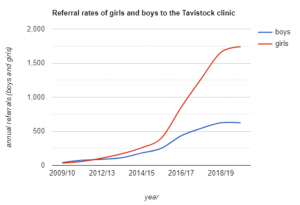 Here are some of the shocking statistics that Stephanie shared with us. Around 75% of those presenting with gender dysphoria are girls, mostly teenage girls suddenly presenting at the start of puberty. This isn’t being looked at properly because these girls are considered to be ‘trans kids’ so it’s not being dealt with as an issue affecting young women. In fact these girls are being seen as boys, despite the fact that Lisa Littman’s study on ROGD (rapid onset gender dysphoria) showed that over 68% of girls presenting with gender dysphoria had pre-existing mental health issues.
Here are some of the shocking statistics that Stephanie shared with us. Around 75% of those presenting with gender dysphoria are girls, mostly teenage girls suddenly presenting at the start of puberty. This isn’t being looked at properly because these girls are considered to be ‘trans kids’ so it’s not being dealt with as an issue affecting young women. In fact these girls are being seen as boys, despite the fact that Lisa Littman’s study on ROGD (rapid onset gender dysphoria) showed that over 68% of girls presenting with gender dysphoria had pre-existing mental health issues.
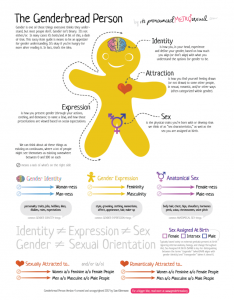
The Genderbread Person, frequently used to teach gender identity in schools and young people’s organisations.
How much better it would be if girls were being taught to feel comfortable in their bodies and focus on what their bodies can do rather than what thy look like. Instead, “they are actually being taught that disassociation from the body is healthy.”
The Genderbread Person resource describes biologcial sex as a quality not a reality. The idea that your gender identity is an essential part of you but your sex is assigned by someone else who may have made a mistake is likely to provoke a huge mental health crisis among young people, observed Stephanie.
This is why she and Rachel Rooney spent so long creating the children’s book ‘My Body is Me’.
Davies-Arai then introduced Rachel, who read her book to us, and we all joined in the chorus “I am my body and my body is me, it’s a wonderful thing I’m sure you’ll agree!”
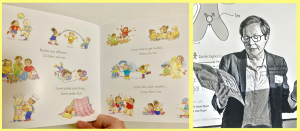
Rachel, a trained teacher in Primary and Special Education with particular interest and experience working with pupils with ASC (Autism), told us that it was Jessica’s suggestion that they named all the children at the front of the book and that the girl called Jasmine is actually based on Magdalen Berns.
“It’s trained into me to celebrate that child, as they are, at that moment, let’s not think about the future, let’s think about their body as it is in that moment, and be positive about it. I didn’t put anything in there about running, for example; I didn’t want to exclude a child who couldn’t run… or a child that couldn’t hear… everything in that book: pooping, weeing, hair growing, being naked in the bath, sleeping – it’s all stuff that any child can do… it’s actually the most inclusive book that you could ever get!”
Stephanie told us that on the Transgender Trend website (where you can also order the book) there is a lesson plan; some teaching notes and worksheets (coming soon) so that the book can be used in schools to teach body positivity.
“The feedback we’ve been getting is that children do repeat the wonderfully positive mantra, “I am my body, my body is me” and what a message to imbibe right from the start! This book challenges gender stereotypes, unlike the trans books which are about affirming a child as transgender and reinforcing gender stereotypes.”
Stonewall have put’ LGBT’ into all aspects of the curriculum and yet the focus is not on the child. She mentions their suggestion ‘listen to music by an LGBT artist’: it’s for the benefit – and the indoctrination- of the teachers rather than having any benefit for the kids.
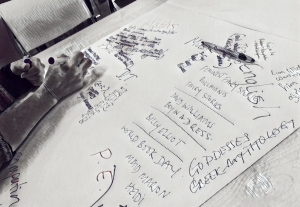
Then Stephanie put us into small groups and asked us to brainstorm ideas about how we could introduce body positivity into the curriculum.
We all agreed that challenging gender stereotypes on its own is no longer enough because trans resources claim to do that.
“We have to actively include body positivity and connection,” affirmed Stephanie,“because alienation from the body and disassociation is such a real problem, especially for girls.”
The ideas flew around and after about fifteen minutes the brainstorming sheets were collected in and participants names were recorded for future credit. This workshop, and the one which followed ours, was a great first step start towards compiling what will become a comprehensive and detailed resource pack for teachers.
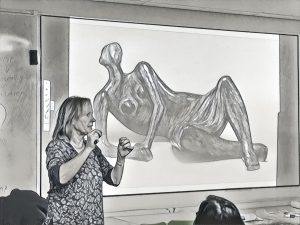 “Sculpture is a good subject for teaching body positivity and awareness,” said Stephanie, herself a sculptor, because it’s a 3-dimensional art form which occupies space.
“Sculpture is a good subject for teaching body positivity and awareness,” said Stephanie, herself a sculptor, because it’s a 3-dimensional art form which occupies space.
“A good sculpture asserts its right to take up space in the world! So getting children to be living sculptures is a good way to get them to experience how that feels in their bodies. ”
She asked us to get up and move around to experience it ourselves.
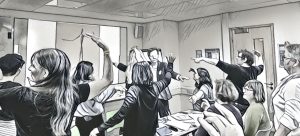
Working with our bodies to become aware of how we occupy space.
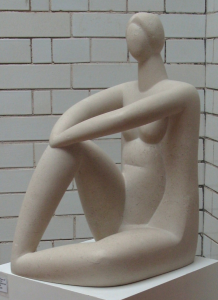
Decorative Figure (after Matisse). Artist: Stephanie Davies-Arai
“Rodin’s The Thinker – can we all be The Thinker? – or Degas Little Dancer – can we all be the little dancer?”
You can be creative with the sculptures you choose, she told us,”doing this activity with children means you’re challenging gender stereotypes at the same time as getting them to connect with their bodies and think about how they occupy space.”
The workshop was both productive and enjoyable; we would happily have carried on for longer but unfortunately we had run out of time.
We pushed the chairs back under the desks, handed in our pens and notes and headed back downstairs.

Making the Media Work for Women
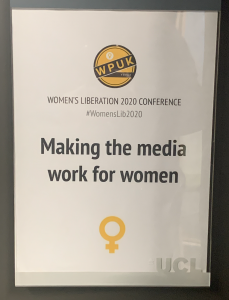
The ‘Making the Media Work for Women’ workshop was run by journalist and film maker Hannah Bayman, senior producer & journalist Nina Goswami, BBC news anchor Reged Ahmad, & Tammi Walker, lead producer for In Plain Sight and ex-social media producer. The room had a large whiteboard in the middle and we were split into groups of about six or seven, sat in four circles of chairs. Each of the workshop co-ordinators spent a short time talking to and with each of the four groups.
Because the groups were quite small and intimate, I didn’t take any photos and only very minimal notes, so this is just a brief synopsis of a session that included a lot more than I’ve mentioned here!

Here are just a few of the things that came out of the session.
Reged Ahmad
If you’re appearing on TV, get make up! Even if you don’t wear it usually. It’s likely you’ll appear pale, sick and ghostly without it because of the lighting. The men wear it too.
Arrive at the studio early. The producer will have looked at a brief so will have an idea of what you want to say. Keep on topic. Be concise. They often aim to ask three questions in three minutes: if your answers ramble, you’ll miss out on the last question.
Record yourself at home. Practise in the mirror. It really helps!
Hannah Bayman
 A press release should read like a news story. Sum up the main theme in one sentence. Whoever is reading it should know what its about as soon as they pick it up, not have to read through paragraphs of waffle. Put in a quote or two. If it’s for TV, they’ll want pictures or photos.
A press release should read like a news story. Sum up the main theme in one sentence. Whoever is reading it should know what its about as soon as they pick it up, not have to read through paragraphs of waffle. Put in a quote or two. If it’s for TV, they’ll want pictures or photos.
If you’re sending an email, make the subject heading the first line of your story. Don’t attach documents, put the body of the text into the email. It needs to be quickly accessible. Check it’s been received. Call the news desk. There’s no harm in reminding people.
If you or your organisation is criticised in the media, you should have a right to reply. The IPSO code concerning Accuracy states ‘A fair opportunity to reply to significant inaccuracies should be given, when reasonably called for.’
Not all organisations are signed up to this code – Pink News for example (quelle surprise) is not; nor is Buzzfeed.
Under English libel law, if content isn’t true you can sue for libel.
Tammi Walker
Many journalists go to blogs and to social media looking for interviews. Use hashtags when you tweet and make valuable contributions to online conversations. Have your DMs open. Requests for interviews or a chat are often immediate. They don’t want to talk to you tomorrow, they want to talk to you now. Ask when it will be broadcast, is it going out live, who you will be on with. Ask what the fee is. There may not be one but it’s worth asking! Be aware of where the story sits in the news cycle. If it’s a Skype interview, keep your background neutral. Focus on the 3 key things you want to say. You can also tell the producer what you don’t want to be asked about. Stay calm. “I’m here to give my opinion so please let me give it.”
“Don’t get labelled as a crazy bitch!” she laughs.
Nina Goswami
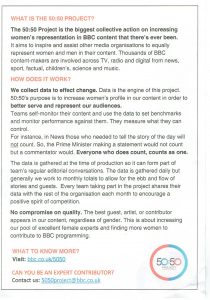
Nina works with the 50/50 Project, encouraging increased representation of women in the media, on TV and online. The project encourages producers to count the men and women on content and aim for a 50% balance.
Email the relevant people with your details, let them know who you are.
Be aware that more and more interviews are now conducted via Skype.
Think about how you can be found on social media- Facebook is bigger than Twitter as far as this is concerned.
Be aware of the possibility of misinformation and hoaxes. Check out those who contact you: you can often confirm that pictures are genuine by using a reverse image search. There are lots of RIS sites available for your phone or your computer.
We ran out of time at that point, and the owrkshop had to come to an end. It was a shame: all four women were helpful, open and a great source of information. It gave us a lot to think about. I would have loved to have spoken to them for longer.
It would have been good to have a break- and more coffee- before the next session, but there was no time. Head buzzing with all that new info I scuttled off to find my second workshop.
Days later, after I’d written this section up, I was going through my bag and found – along with the unicorn hairbrush – this handout we were given at the end of the session.
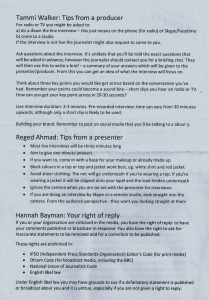
Coffee break
Before the final plenary, we had half an hour for a quick break, more coffee and a chance to return to the Feminist Marketplace. Here there was shopping to be done, art to be viewed and, over the course of the day, stands and stalls from the following groups and organisations:
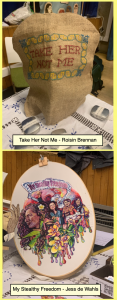
 Rummaging through second-hand books I found a bargain second-hand copy of Simone de Beauvoir’s ‘The Second Sex’ for Estelle, who had attended the ‘Becoming Woman – sex-based socialisation and the Second Wave’ workshop and had been feeling guilty that she hadn’t got around to reading the book beforehand. I bought some gorgeous embroidered iron-on patches from the talented Jess de Wahls.
Rummaging through second-hand books I found a bargain second-hand copy of Simone de Beauvoir’s ‘The Second Sex’ for Estelle, who had attended the ‘Becoming Woman – sex-based socialisation and the Second Wave’ workshop and had been feeling guilty that she hadn’t got around to reading the book beforehand. I bought some gorgeous embroidered iron-on patches from the talented Jess de Wahls.
There were lots of feminist badges for sale, and who knows, they might someday become iconic collectors items, so I bought a couple of those for my collection.

I was happy to see the LGB Alliance had a stall at the conference, even more so as I’d been wanting to get one of their T shirts. The half an hour break passed too quickly and before I knew it, it was time to head back to the main hall for the final plenary.

The Final Plenary
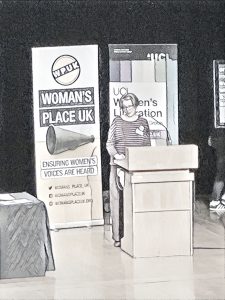
Holly Smith
We filed back into the hall, discarding coats, kicking bags under seats and rummaging for pens in our bags.
The hall was once again filled to capacity. We took our seats and settled down as Holly Smith introduced the speakers for the final Plenary.
![]()
Joan McAlpine

Joan McAlpine
McAlpine began by quoting John Stuart Mill:
“When we silence an opinion, we rob the human race. We rob posterity as well as our own generation. We rob those who dissent from that silenced opinion, even more than those who hold it.”
Emphasising the importance of discussing and testing your own opinions in debate, she reminded us that silencing women had always been the most effective way of controlling them. Women are still silenced, in all walks of life, and violence is often an effective method used against them.
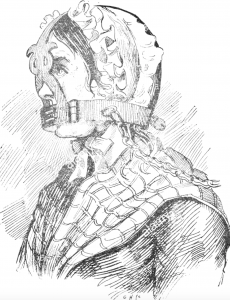
The Scold’s Bridle
Despite the violence – she referenced the ‘Scold’s Bridle’ from medieval Scotland- the most effective way of silencing women is by ostracising them from society.
The anthem of the women’s liberation movement, half a century ago, was Helen Reddy’s 1971 hit song ‘ROAR‘ which symbolised “the collective voice of millions of women in second wave feminism that gave us reproductive rights, that challenged and exposed male violence through self-organisation, that demanded equal pay, that tried to reclaim the night, that dissected sexism and deconstructed codes of dress and behaviour designed to feminise and infantalise women.”
McAlpine is a member of the Scottish National Party (SNP), a social democratic movement working to achieve autonomy for Scotland. She paid tribute to Nicola Sturgeon, the Party’s leader, calling her “the most effective politician in the whole of the UK”. Sturgeon has a ’50/50′ cabinet and has made huge strides in domestic violence legislation and early years childcare provision. Proud as MCAlpine is to be a member of the SNP, she acknowledged that there are difference of opinion, as in any progressive party.
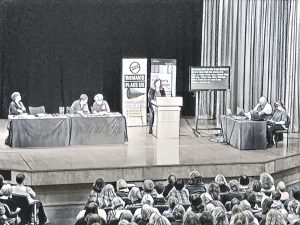
McAlpine addresses the audience
“My journey to the platform today began when I became embroiled in difference of opinion about how we collect data.” Joan informed us.
 Referring to Perez’s book “Invisible Women’ (out in paperback on 5th March) which explores how everything is designed for men ‘by default’, she asserted that recording sex accurately is essential in order for us to design a world which is equally suited to women.
Referring to Perez’s book “Invisible Women’ (out in paperback on 5th March) which explores how everything is designed for men ‘by default’, she asserted that recording sex accurately is essential in order for us to design a world which is equally suited to women.
The 2018 Census Amendment Bill proposed to change a line in the 1920 census act which changed ‘sex’ to ‘sex, including gender identity’, and also to include a third option.
Many women objected and worked against the bill, and the committee agreed that debate was needed. The backlash against these women backfired, causing people to ask the question, “how could a statement like ‘sex and gender identity must not be conflated’ be considered ‘hate speech’?”
The National Records office decided to speak to grassroots women’s groups; and eventually a majority of the committee recommended the sex question remained binary. The government agreed, also amending the bill to drop any conflation of sex and gender identity.
“If society conflates sex with identity, what happens to sex specific stats on violence and equal pay?” asked McAlpine. “What will happen to the concept of same sex attraction? How will we maintain single sex spaces in prisons, changing rooms, hospitals? If sex is a matter of identity, how can we continue to reserve jobs for females in order to protect privacy and dignity, such as intimate personal care? How can we protect female sports?”
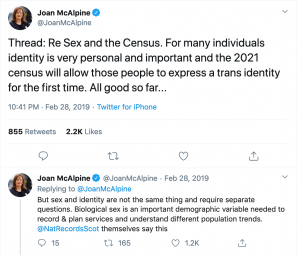
In June 2019, McAlpine won ‘Tweet of the Year’ at the Scottish Politics Awards, for her thread on sex, identity and the census.
McAlpine told us she’d become interested in this subject after reading the writng of Kathleeen Stock, WPUK and Fair Play for Women. After she spoke up, she said, others found it easier to speak up too. They formed the SNP Woman’s Pledge and gathered thousands of supporters. Because of this bravery. there has now been a statement in Parliament acknowledging the concerns of women and the process of reforming the GRA has been at least slowed down.
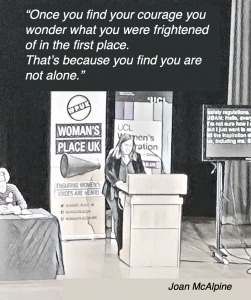
“We have now had Maya Forstater speak in Parliament, Maureen O’Hara, Karen Ingala Smith, Rebecca Bull and Anya Palmer. The sky did not fall in.”
Joan urged everyone to respond to the new Scottish consultation into the proposed Gender Recognition Reform Bill, The consultation closes on March 2020. She reminded us that the consultation is open to everyone and assured us that “supporters of self identification around the world are already sending in their responses in a well co-ordinated, well-funded campaign.”
More information about the consultation is available at ForWomenScotland
McAlpine conlulded by saying she hoped she had convinced us that courage could be catching, and that Westminster would catch some of the courage demonstrated by Scotland.
“I believe in human rights for everyone. But woman’s rights are human rights and CONSENT is at the heart of women’s rights. That means ‘nothing about us without us’.
You can read Joan McAlpine’s full speech here.
![]()
Julie Bindel

Julie Bindell
It goes without saying that I want to thank profusely WPUK and the amazing work they continue to do,” began Bindel. She added that she wanted specifically to thank Holly Smith, Alice Sullivan and Judith Suissa.
She then thanked the ‘children’s entertainers’ who met us at the door on our way in to the conference.
It is important to keep moving onwards in any political struggle and Julie especially wanted to address the young women in the room. For them, she thought the current situation was ‘hellish but full of possibliities’.
“We understand that your lives are full of things that we in out twenties could never have comprehended… the vile misogyny, the toxic misogyny… we have always had a women’s movement but this is a pivotal moment.”
She warned of the ‘neo-liberal politics of the individual’ which focused on ‘ridiculous, meaningless identities’, calling it ‘identity politics without the politics’.
“By saying women are a sex class and men are a sex class, we don’t mean that Kate Middleton is oppressed by a man of colour who is homeless and jobless, we mean like for like. We mean that men – yes, all men- oppress women structurally in every bit of society in every country of the world.”
It is hard for young women today to have a sense of the women’s movement because of a lack of connectivity between generations of feminists. Many young women think that the advances in women’s rights that we have gained – the illegality of rape within marriage, for example – ‘ just happened organically‘. They don’t always understand the fight that has gone before them, that the rights that they take for granted have been hard fought for by the women that went before them.
Bindel spoke of the currrent culture of ‘feminism for men’, the idea that transwomen are female and how young women are told they just have to ‘be kind’ – even to rapists in prison who say they are women.
An Australian feminist had once told her that the only time the phrase ‘her erect penis’ should be used was when a woman had castrated her rapist and was holding it up as a trophy.
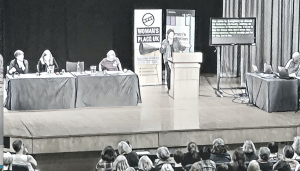
Julie Bindell addresses the conference
Bindel spoke of the feminists she met as a teenager who mentored and supported her. Now she believes such actions would be seen as condescending by some young women: she laughed, ‘fuck off you patronising boomer‘.
How we support each other is important. We need to get back to the truth of how we form a political movement and how we protect those who might really be harmed by those who are scared, or have more to lose by speaking out. There is a privilege that comes with age and experience, and it is harder for the young who often have more to lose. There are always some who have more to lose than others. She suggested that our job as older feminists is to say to young women, ‘how do we support you?’.
We need real-life friendship groups and it’s important to get offline, meet up with each other and maybe take part in a bit of direct action: “of course, you’re not going to sit and look at your cervixes these days” – laughter- “that was back before the internet!”
Julie reckoned that if she had brought the young protestors outside into the hall, into the workshops and discussions, they might have heard something that resonated with them. They need this education. It wasn’t until she met feminists that she learned “there is a pride in being a lesbian, in saying that we’re lesbians… they stopped me thinking this was the most disgusting word on the planet.” Now this is being thrown away.
“Where do working class women go,” asked Bindel, “to talk about the abuse they’re getting in their relationships and their communities? The self hatred they’ve been taught. Because let’s be honest, all of this ‘unicorn blue fringe’ stuff – it’s class. It’s privilege. I’ve talked to feminists in countries around the world, from Kamapala to Karachi, who say ‘what the fuck is going on?”
Identity politics is irrelevant to material reality. Women all over the world are different, but are united by the fear and reality of male violence.
She called for us to move onwards and upwards, concluding, “We don’t have to die on any hill, but we definitely have to be on the hill.”

When the applause had died down, Holly introduced Kiri Tunks, “teacher and trade unionist, and co-founder of Women’s Place UK; one of the organisers of this conference… WPUK was born out of defensive struggles… but as today demonstrates, WPUK has grown to stand for women’s liberation in a much broader sense.”
More applause greeted Kiri as she stood up to speak.
Kiri Tunks
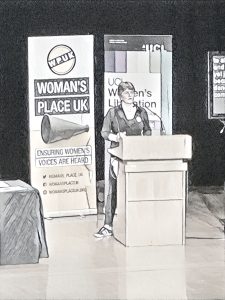
Kiri Tunks
“It falls to me to make some closing remarks…”
Tunks thanked UCL “for hosting this event and demonstrating a commitment to academic debate and women’s rights.”
She also thanked the UCL Women’s Liberation Special Interest Group, “an incredible bunch of women and the best hosts you could hope for- you want them on your side in a fight!”
She thanked the UCL staff, the stenographers, volunteer helpers and the stall holders, creche workers, the speakers, facilitators and contributors and all those who attended.
Finally, she thanked all those who had been in the fight longer than WPUK, which was formed in September 2017.
“We know there are a multitude of individuals, campaigns, groups, organisations out there with huge expertise and experience in the full range of women’s lives.”
Many groups feel unable to enter into the debate for fear of threats to their funding. WPUK is funded by supporters and through ticket sales and donations, so has no such constraints. The conference, she said, was to mark 50 years since the first Women’s Liberation Movement conference in Oxford and to reflect on the past and look to the future. The aim of the conference was to allow women to ‘come together and meet; to take stock; to network; to plan; to get informed; to discuss and debate; to laugh; to leave with a 100 ideas of what we can do next in our communities to change the lives of women and girls for the better, and to build a society that works for all.’
Kiri compared the conference to a patchwork quilt, “made up of different pieces, sewn by different people, all brought together in one rich, eclectic, whole.”
Hoping the day had fired us up and made us feel strong, she called on us to return to our communities and organise.
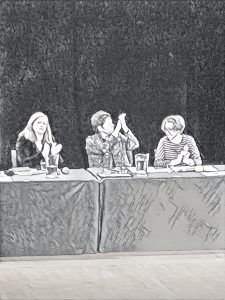
McAlpine, Bindel & Smith applaud Tunks
“We need to build this movement in every village, town and city to ensure that women’s voices are heard and their rights upheld.”
It is down to us,” she concluded. “All of us. This is a movement, we are a movement. Let’s move!”
You can read Kiri Tunks full speech here.

The final Plenary over, we cheered and stomped our feet with enthusiasm. Holly took to the stand and reminded us there was an opportunity between five and six to meet and network with other people in our region. Follow the signs! She reminded us the cloakroom closed at 6pm but that we could stay in the bar until 9pm.
The raffle was drawn but I didn’t win. 🙁

The end of the closing plenary
I popped in to the networking session for my region, which was thriving. The room was divided into groups from various parts of London and ideas and contact numbers were being shared and exchanged. I didn’t stay very long because I was keen to get back to the bar to meet with some friends who were having a champagne celebration over a recent a successful project, and also to discuss a plan I have in the pipeline. It was inspiring to see so many women gathering together ‘in real life’ to discuss the issues that affected them and action that could be taken.
It is so much more productive meeting and planning IRL than on social media. There were so many people to say hello to and so much to talk about! After nine, many women were heading off to another bar, but it had been a long day and I felt like heading home.
Estelle was going my way, so we walked to the tube station together. I noticed she wasn’t wearing her yellow ribbon any more.
“I took it off quite near the beginning,” she said. “I get why some people really can’t be photographed but after listening to the women on stage who had all decided to stand up and be counted, I just felt I couldn’t sit there with my ribbon on. I thought it was the least I could do.”
She pulled it out of her pocket, crumpled in her hand.
“I’m going to keep it though.” she said. “Estelle’s last stand. My own little back row rebellion.”

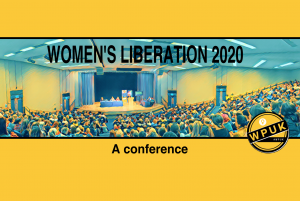
Thank you for writing this Lily. I was lucky enough to be able to attend the event, and it was fantastic to meet so many women (and a few men) who I’d only spoken to online over the last couple of years.
Being able to talk to and listen to so many inspirational people has only strengthened my resolve to continue the fight for the rights of women and children against this toxic and regressive ideology. It’s also given me the confidence to talk to those who either don’t know what’s been going on or were undecided on the issue.
I’m convinced that we’ll win this. They say sunshine is the best disinfectant and I’m discovering this more and more. Let’s keep shining a light into those dark corners.
Pingback: Jess de Wahls & the new censorship |Lily Maynard
Pingback: Heretic - Jess de Wahls & the new censorship |Lily Maynard
Pingback: YES, BUT WHAT DO THEY ACTUALLY WANT ??? -Lily Maynard